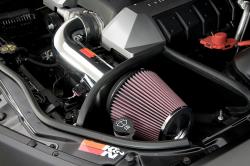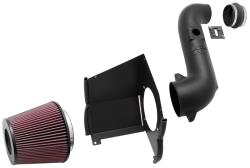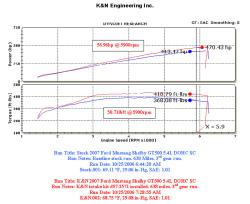
A K&N cold air intake can add power and good looks without sacrificing protection | There is nothing better than buying a new car, especially a muscle car. Whether you are the first owner or the 15th, driving down the road in your new, big horsepower car gives you a rush that is almost unmatched. However, after some time, that new car loses its novelty and begins to feel old. To bring back that new car feeling, people will naturally turn to modifications. Whether it is a new set of wheels or even a new radio, these types of changes help to restore your love for your car again - especially if it is something that will add power to your car.One of the popular modifications to modern muscle cars is a cold air intake. Both the big V-8s and the turbo four cylinders respond very well to additional air. With extra air to feed the ponies, the car’s ECU can trigger more fuel, and what comes out the other end is increased horsepower, torque, and acceleration. This occurs without any other modifications and with an install that is around just 90 minutes to complete. We recently took a trip to one of the leaders in the cold air intake industry, K&N Engineering, to see what makes these intakes better at feeding these hungry motors the cold air they want. 
There are not a lot of pieces to a K&N cold air intake, but what there is helps add HP and torque | Companies like K&N Engineering have been marketing cold air intakes to consumers for close to three decades now. These products are said to increase the amount of air getting to the engine. This air is also said to be cold, or at least cooler, than the outside air. Cold air is denser with more oxygen molecules than warm air. Thanks to the vehicles mass airflow and O2 sensors, the ECU can accommodate this extra oxygen with more fuel, creating more explosive and complete combustions. These more efficient combustions directly translate to more power. But the question is how exactly do these cold air intakes help the engine get more air?To answer this, let’s break down what these cold air intakes consist of. Obviously each vehicle is different, but the majority of these kits contain three major components: a filter, an air box or heatshield, and an air tube. To start things out, we will examine how the filter differs from the stock air filter. K&N includes tubular or conical air filters with their cold air intakes. These filters are made of a pleated cotton gauze material. The cotton is soaked with a special type of tacky oil to trap dirt and dust impurities. It may come as no surprise that cotton gauze has the ability to flow more air than the folded paper that most OEM filters are made out of. These filters are also washable and reusable, so there is no need to buy a new filter every year. 
The K&N 57-2571 kit for the 2007-2009 Shelby GT500 adds an estimated 56 horsepower | The air filter is housed in either a self-sealing heatshield or an air box. These both accomplish the same thing in helping to keep hot air out and letting cooler outside air into the filter. That ensures consistent power gains, no matter how warm the engine of the vehicle is. From the filter, air passes into an air tube. K&N offers a variety of different styles of air tubes depending on individual preference and needs. The basic kind is a black plastic tube. The good thing about these is it allows R&D freedom in how they design the intake. If there are obstacles in the way or tight tolerances, the mold for the air tube can be made to accommodate those specific demands. The other styles are polished or powder-coated aluminum tubes. These offer unique options for individual style preferences like chrome, black, silver, or even red. No matter what style you pick, they all offer a smooth path with minimal turbulence for the air to travel. This is important because the smoother the air is when entering the intake manifold, the better the fuel can atomize with the air.All of these benefits help to add to that horsepower increase that K&N guarantees with every intake. Typically, you can see an estimated increase of 10-15 HP with the addition of a cold air intake. But, depending on your application, you could see more. The K&N 57-2571 kit for the 2007-2009 Shelby GT500 adds an estimated 56 horsepower and the K&N 69-2550TTK adds an estimated 39 horsepower to 2015-2016 Charger Hellcats. If you would like to see what K&N has to offer your muscle car, early or late model, check out knfilters.com |













